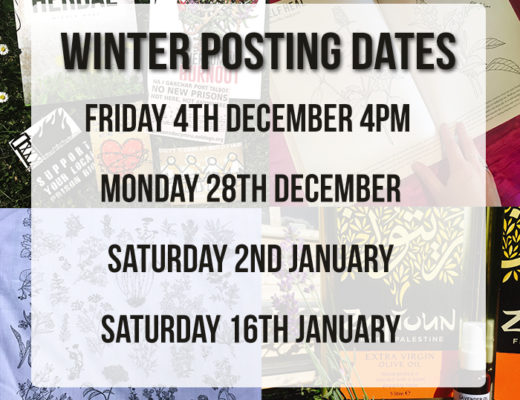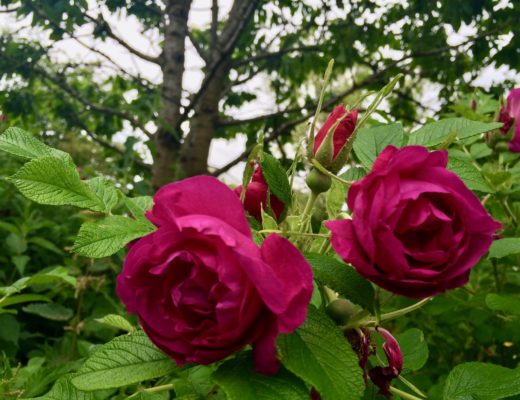Please note these plant profiles are a work in progress. I will always be adding to them as I keep learning about the amazing world of plant medicine.
Botanical Overview
Latin name: Plantago major, Plantago lanceolata
Plant family: Plantaginaceae
Identification: Ribwort plantain (P. lanceolata) has low rosettes of narrow, dull or greyish-green, hairy leaves with numerous parallel veins running the length of the leaf. Leaves taper very gradually to their narrow bases and very short stalks. They have short, dense, blackish flower heads (with creaming stamens) on leafless stems. In comparison, Greater Plantain (P. major) has broader leaves which are hairless or with short hair and taper more abruptly into distinct leaf stalks which can be as long as the leaves themselves. The flower head is long, narrow and green (brown when dead)(1).
Other species: Narrow leaf plantain (P. minor), Sea plantain (P. maritima), Indian plantain (P. afra), Psyllium (P. ovata). All 34 species of plantain are edible and medicinal.
Folk names in English: Ribwort plantain (P. lanceolata), Greater plantain (P. major), Waybread, Snakeweed, Soldiers, Kemps, Fireleaves, White Man’s Foot, White Man’s Footsteps, Waybroad, Ripple Grass, English man’s foot, Broadleaf, Cuckoo’s Bread, Rat-tail. Planta in latin means foot.
Chemical constituents: Iridoid glycosides (aucubin, catalpol); tannins; polysaccharides, (galactose, glucose, xylose, arabnose, and rhamnose IE mucilage); alkaloids (plantagonine, asperuloside); flavonoids (baicalein, apigenin, scutellarin, nepetin, hispidulin, luteolin, plantagoside) (10).
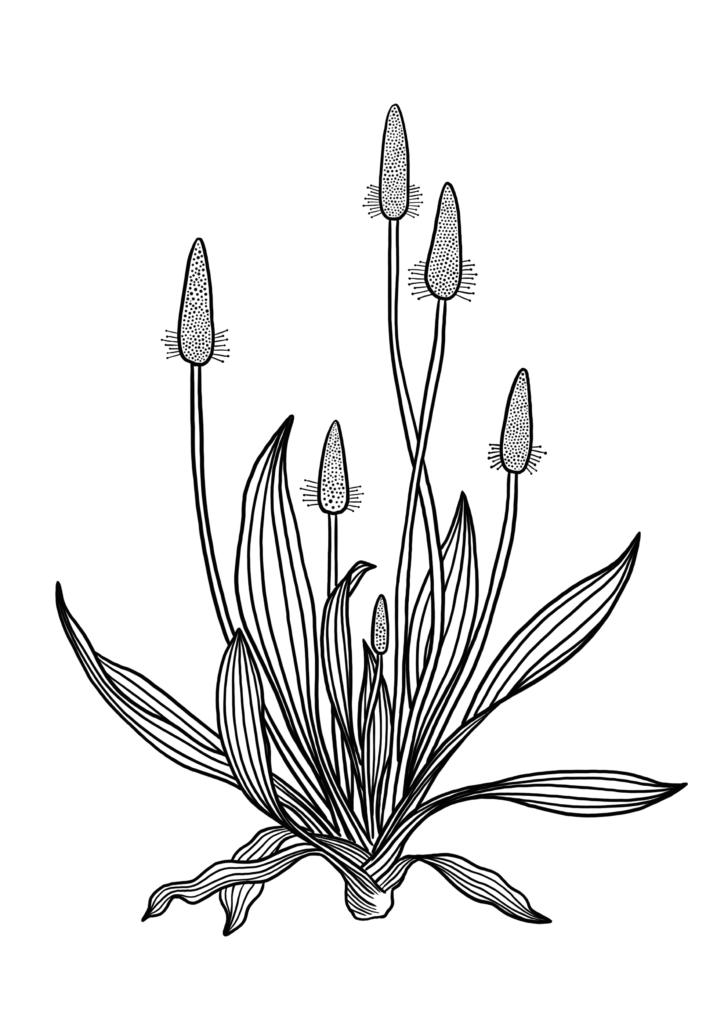
Drawn by Amani Omejer for my upcoming Prisoner’s Herbal book
Food and nutrition
All parts of plantain are edible. Mark Pedersen writes in Nutritional Herbology that Plantago major seed is very high in calcium, crude fibre, dietary fibre, and fat. It is also high in protein, silicon, sodium and zinc. Katrina Blair describes how “plantain seeds are a sustainable food rich in proteins, carbohydrates, fatty acids, amino acids, omega-3 fatty acids and other minerals. The seed coat is made up of 30% mucilage. The mucilage absorbs toxins in the digestive tract and greatly supports effective elimination. The seeds act gently in lubricating the colon with mucilaginous nature, making the perfect food and medicine in one. The plantain seeds are a relative of psyllium seeds (P. ovate) and have the same gelatanious quality – making a valuable base for thickening soups in recipes, for binding crackers and firming up deserts” (5). P. lanceolata is also grown as a perennial salad crop in Italy and other parts of Europe (2).
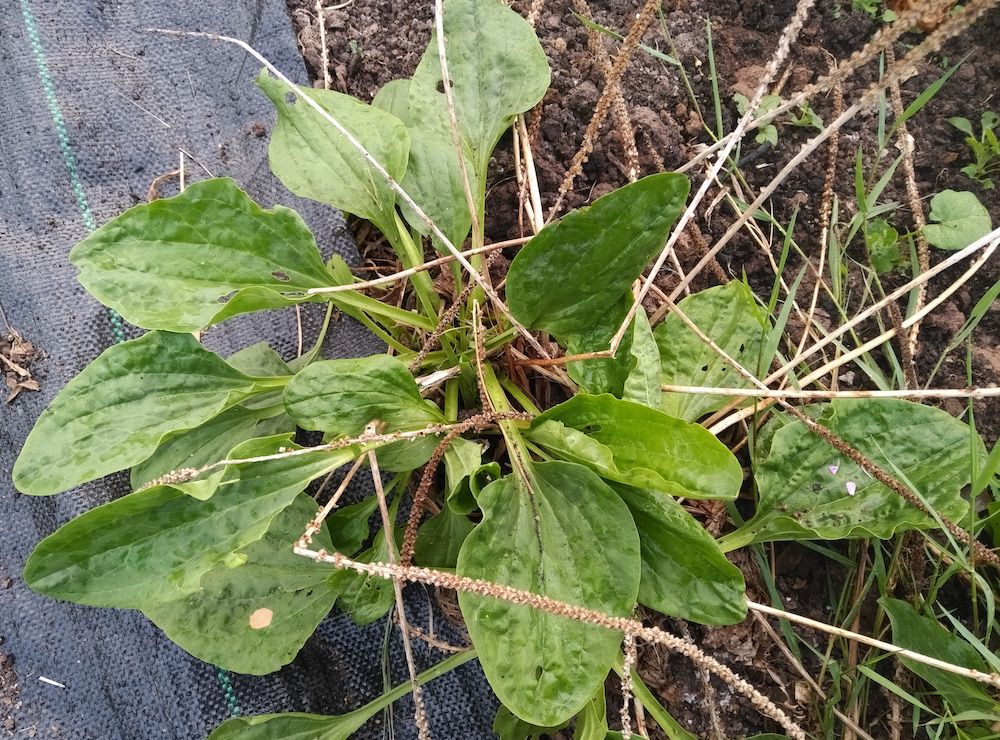
Plantago major
Ecological role
Plantain grows on dryish neutral to basic soils, in short, grazed, unimproved grasslands and also in improved grasslands, along hedgerows and roadsides, and on wasteground (1). Plantain is an excellent cover crop for soils harmed by extractive European agriculture or repeated trampling. She also makes good forage for animals domestic or wild. (7). You will see plantain wherever there is bare soil, she is somehow the land’s living plaster.
Plantain is called ‘white man’s footsteps’ because of how it followed European settlers on native land. Robin Wall Kimmerer, author of the beautiful book Braiding Sweetgrass, describes plantain:
“Our people have a name for this round-leafed plant: White Man’s Footstep. Just a low circle of leaves, pressed close to the ground with no stem to speak of, it arrived with the first settlers and followed them everywhere they went. It trotted along paths through the woods, along wagon roads and railroads, like a faithful dog so as to be near them.”
I love how Hawthorn references plantain as a tool for decolonisation. They write “Plantago reminds us that good allies take the back seat. They remain unobtrusive and supportive until called upon. They do not take up extra space or time that others need. Unlike other introduced plants (buckthorn, knotweed, etc.), plantain has not disrupted ecosystems or threatened endangered native species. She only takes up space where there are already empty spots — putting herself at the edge of eroded areas or busy sidewalks. She helps keep the soil healthy by holding it in place and healing compaction but then moves on to allow others to thrive.” (7)
Cultivation: Plantain commonly propagates itself via seed, with one source saying that plantain seed can remain viable for up to 60 years! (9). While plantain is generally found on bare and disturbed soils, where it does have access to more fertility it will become impressively lush and large! We commonly nurture plantain in our polytunnel paths.
Energetics
- Temperature: Cooling
- Moisture: Astringent and demulcent
- Tissue State: heat/excitation, dry/atrophy, damp/stagnation
- Taste: Bitter
Health challenges supported by Plantain:
Herbal actions: Alterative, antibacterial, antidote, astringent, antiseptic, demulcent, deobstruent, diuretic, expectorant, febrifuge, hemostatic, ophthalmic, vulnerary, inflammation modulating, moistening expectorant
Plantain has been used medicinally for thousands of years. It was one of the nine sacred herbs of the anglo-saxons, who called plantain “Lacnuga, the mother of worts” (5). Below are some medicinal uses of plantain:
Topical first aid: Plantain is a supreme ally for wound healing and skin injuries. From bites, cuts, scrapes and stings to puncture wounds, Plantain is your plant! This is because Plantain works simultaneously as a fantastic drawing agent and as an astringent and vulnerary. In Ireland a single plant leaf served both actions – one side of the leaf was meant to be used for drawing out, and the other side of the leaf for healing (3). Plantain has the ability to suck out dirt, splinters, stings and poisons. I remember being bitten by a spider (or some other mystery insect) while being at a hardcore show after leaving my hoody in a dusty cupboard. I searched outside and even in the middle of the city in Bristol, I found plantain growing through the concrete. I washed it and chewed it up in my mouth before placing it on my bite, and low and behold, I drew out whatever had gotten in there and the swelling subsided.
Plantain also has the ability to treat infected wounds due to its antibacterial and antiseptic actions. Herbalist Sajah Popham writes how, “Plantain applied topically has the ability to draw out that infection, bring fresh blood to the surface, stimulate local immunity, detoxify the area, and provide it’s own antiseptic properties” (10). Cat Ellis in her book Prepper’s Natural Medicine uses Plantain in her emergency medicine kits, including it as part of an anti-infection salve, a snakebite and toxin drawing salve and wound wash (11). Plantain can also be added to medicated clays. It’s also just super powerful as a ‘spit poultice’. A loved one of mine from Siberia jokes that in Russia, Plantain is used for everything, with a comedy sketch that if your arm gets chopped off, just use Plantain.
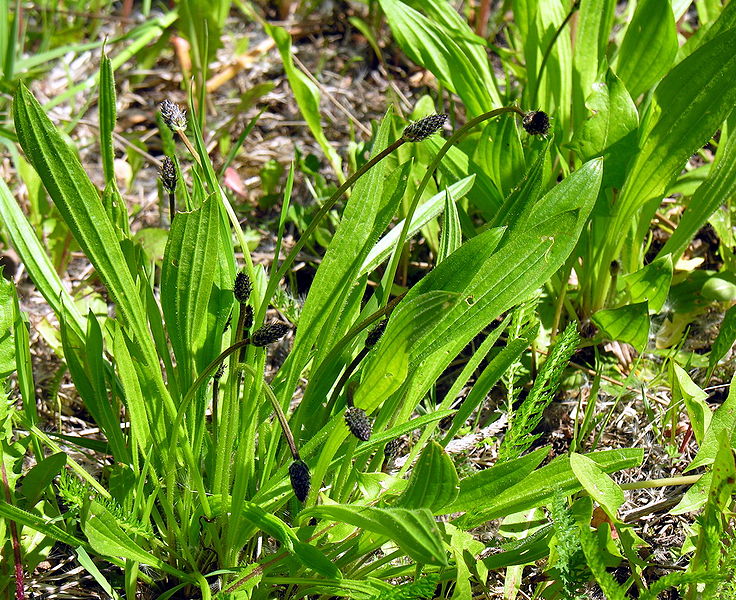
Plantago lanceolata
Leaky gut syndrome: With gut issues almost endemic in our western cultures due to chronic stress, antibiotic trauma, food allergens and intolerances, non-organic food and pollution, Plantain can be an important ally. This is due to it’s astringent and vulnerable action literally healing our internal wounds (imagine the gut lining as our inner skin). Sajah writes, “Once again, we see the combination of astringency/vulnerary actions helping to heal and tonify the lining of the gut, a reduction in inflammation directly on the gut wall but also systemically, a soothing demulcent action, as well as the antiseptic quality helping to alleviate any possible flora imbalances or infection. Plantain is literally like a formula unto itself when it comes to treating leaky gut syndrome! The slight bitterness of the remedy also supports digestion as a whole” (10). If using Plantain for gut healing, then similarly to mallow, you need to really cover as much surface area as possible so decoctions or infusions are best.
Constipation: Psyllium husks are a common treatment for constipation, adding a bit of moisture and a bulking laxative to help getting things moving. Plantain can also be used for hemorrhoids.
Respiratory Tract Infections: Plantain is a fantastic resource for a dry irritable cough because it is soothing and moistening but also has an expectorant action. It’s great if you have one of those lingering coughs that will not go away easily.
Dental care: Herbalists Julie and Mathew Seal write how a wad of fresh Plantain can be placed against sore teeth and gums. It’s drawing action is particularly powerful for tooth infections, canker sores or aphthous ulcers. Tea can be held in the mouth, or you can soak cotton wool in a strong infusion or tincture and pack it into the area.
Urinary Tract Infections: Sajah describes how Plantain is a good herb for urinary tract infections, “The herb is a mild but effective diuretic agent, providing it’s astringent and mucilaginous properties to the mucosal membranes which line the urinary tract. This makes it highly beneficial for urinary tract infections where there is an excess of irritation, heat, dryness and bleeding. Plantain effectively cools and sedates the heat and inflammation, soothes the irritation, moistens the dryness, astringes the bleeding, assists in drawing out the infection, and also provides an antiseptic action and a bit of local immune stimulation” (10).
Plantain and the Solidarity Apothecary
Plantain will be featured in the upcoming Prisoner’s Herbal book that I am writing. Many folks who have experienced traumatising state violence often have digestive issues and so Plantain is a fantastic ally. Likewise, it as an essential addition to first aid kits for actions, protests, occupations and so forth.
Sources
1. Plants and Habitats, Ben Averis
2. Hedgerow Medicine, Julie Bruton-Seal and Mathew Seal
3. Medicinal Plants in Folk Tradition. An ethnobotany of Britain and Ireland, David E. Allen and Gabrielle Hatfield
4. Nutritional Herbology, Mark Pedersen
5. The Wild Wisdom of Weeds, Katrina Blair
7. https://webcache.googleusercontent.com/search?q=cache:B2xwvtIVEJEJ:https://thehedgerowwi.com/2018/12/09/plantago-major-learning-allyship-from-white-mans-footprint/+&cd=1&hl=en&ct=clnk&gl=uk&client=firefox-b-d
8. Braiding Sweetgrass: Indigenous Wisdom, Scientific Knowledge and the Teachings of Plants, Robin Wall Kimmerer
9. https://awkwardbotany.com/2015/05/13/ethnobotany-white-mans-foot/
10. Plantain monograph, Materia Medica Monthly produced by the Sajah Popham at the School of Evolutionary Herbalism
11. Prepper’s Natural Medicine, Cat Ellis



